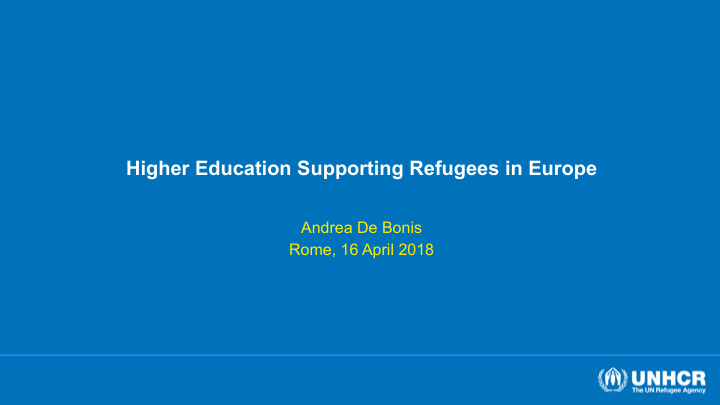



Higher Education Supporting Refugees in Europe Andrea De Bonis Rome, 16 April 2018
Objectives • UNHCR • International Law on Asylum • CEAS • Global Trends 2016 • Mediterranean route
UNHCR • created in 1950 • Humanitarian Agency • UNHCR is present in 145 countries
UNHCR mandate • Give International protection to the refugees • Find durable solution for the refugees: Voluntary repatriation Integration Resettlement
Who help UNHCR? • Refugees • Returnees • Internal Displaced Persons • Asylum Seekers • Statelessness
International Refugee Law • Universal Declaration of Human Rights (1948) • Convention relating to the Status of refugees (Geneva, 1951) • Protocol relating to the Status of Refugees (New York, 1967)
Universal Declaration of Human Rights Art. 14 “Everyone has the right to seek and to enjoy in other countries asylum from persecution”. • Right to seek asylum in another country Right to enjoy asylum in another country • Right to obtain asylum? •
Geneva Convention on Refugee Status 1951 • Definition of refugee • Principle of non refolument • Refugee rights
Who is a refugee? Art. 1 Geneva Convention “Owing to well-founded fear of being persecuted for reasons of race, religion, nationality, membership of a particular social group or political opinion , is outside the country of his nationality and is unable or, owing to such fear, is unwilling to avail himself of the protection of that country; or who, not having a nationality and being outside the country of his former habitual residence as a result of such events, is unable or, owing to such fear, is unwilling to return to it”.
Principle of non refoulement Art. 33 Geneva Convention “ No Contracting State shall expel or return ( refouler ) a refugee in any manner whatsoever to the frontiers of territories where his life or freedom would be threatened on account of his race, religion, nationality, membership of a particular social group or political opinion”.
Principle of non refoulement ▪ Internationally recognized principle ▪ Cornerstone of the right of asylum and of international refugee protection ▪ Part of international customary law Applicable to: ▪ Expulsion and deportation from the territory ▪ Rejection at the borders ▪ Indirect refoulement (chain deportation)
Regional Instruments on Refugee Law • Regional Refugee Law Instruments: – Reflect the further evolution of IRL; – Broaden the concept of refugee, adequating it to regional realities; – Eliminate protection gaps; • 1969 OAU Convention Governing the Specific Aspects of Refugees Problems in Africa; • 1984 Cartagena Declaration.
CEAS (Common European Asylum System) Tampere programme 1999. • Amsterdam Treaty (1997>1999). Asylum under the III pillar. • • Nizza Treaty (2001>2003) first phase on the minimum common rules. • Aja Programme, November 2004. • Lisbon Treaty (2007>2009) II phase: from minimum common rules to the Common system Stockholm Programme, 10 December 2009. Update and development. • European Commission communication, April 2016 – Towards a reform of • the Common European Asylum System and enhancing legal avenues to Europe.
Common European Asylum System Reception Qualification Procedure Eurodac Dublino
International protection • Refugee status • Beneficiaries of subsidiary protection
Subsidiary protection Art. 2 (Qualification Directive – 2011/95/EU) Person eligible for subsidiary protection “…a third country national or a stateless person who does not qualify as a refugee but in respect of whom substantial grounds have been shown for believing that the person concerned if returned to his or her country, would face a real risk of suffering serious harm ..”
Subsidiary protection Art. 15 (Qualification Directive) Definition of serious harm • death penalty or execution; or • torture or inhuman or degrading treatment or punishment • serious and individual threat to a civilian's life or person by reason of indiscriminate violence in situations of international or internal armed conflict.
Refugees are people fleeing conflict or persecution. They are defined and protected in international law, and must not be expelled or returned to situations where their life and freedom are at risk.
First time asylum applications in EU First time applications in EU28 by year 1257610 1205535 563345 504000 373620 (312,750 Jan-Jul 2017) 2013 2014 2015 2016 2017*
Sea arrivals, dead and missing Mediterranean Sea Arrivals by year Dead and missing by year 1015078 5096 3771 3538 2421 362753 216052 121735 636 60000 2013 2014 2015 2016 Jan-Aug 2017 2013 2014 2015 2016 Jan-Aug 2017
Sea arrivals in Italy
A more predictable and equitable way of responding to large movements of refugees is called for through the adoption of a global compact on responsibility-sharing for refugees, and the elements of a comprehensive response plan for refugees are set out”. Ban Ki Moon - In safety and dignity: addressing large movements of refugees and migrants. April 2016. “I’m here today -- I called this summit -- because this crisis is one of the most urgent tests of our time -- our capacity for collective action. And finally, this crisis is a test of our common humanity -- whether we give in to suspicion and fear and build walls, or whether we see ourselves in another”. Barak Obama – New York 20 September 2016.
Integration is the challenge
Thank you debonis@unhcr.org data.unhcr.org/Mediterranean www.unhcr.it
Recommend
More recommend